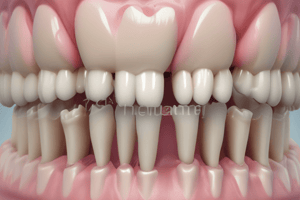Podcast
Questions and Answers
Fixed restorations can only be attached at the implant level and never at the abutment level.
Fixed restorations can only be attached at the implant level and never at the abutment level.
False (B)
Using a one-piece implant is recommended for narrow spaces and with Zirconia implants.
Using a one-piece implant is recommended for narrow spaces and with Zirconia implants.
True (A)
Excess cement in fixed restorations is linked to signs of peri-implant disease in a significant majority of cases.
Excess cement in fixed restorations is linked to signs of peri-implant disease in a significant majority of cases.
True (A)
Two-piece implants provide no advantage during the bone healing phase as they remain permanently loaded.
Two-piece implants provide no advantage during the bone healing phase as they remain permanently loaded.
Cement retained one-piece implants offer great diversity in abutments and are ideal for all situations.
Cement retained one-piece implants offer great diversity in abutments and are ideal for all situations.
One-piece implants can be beneficial in situations with limited space.
One-piece implants can be beneficial in situations with limited space.
Cement retained one-piece implants allow for a significant range of abutment options.
Cement retained one-piece implants allow for a significant range of abutment options.
Using excess cement during implant procedures has not been linked to any complications.
Using excess cement during implant procedures has not been linked to any complications.
Two-piece implants provide the advantage of being loaded during the healing phase.
Two-piece implants provide the advantage of being loaded during the healing phase.
Zirconia implants necessitate informing the patient and selecting an appropriate diameter before placement.
Zirconia implants necessitate informing the patient and selecting an appropriate diameter before placement.
The position of a one-piece implant is not critical compared to two-piece implants.
The position of a one-piece implant is not critical compared to two-piece implants.
The primary advantage of using a telescopic crown is to help achieve a better cosmetic outcome.
The primary advantage of using a telescopic crown is to help achieve a better cosmetic outcome.
Flashcards are hidden until you start studying
Study Notes
Restorative Options Overview
- Restorative options for dental implants include fixed (cement-screw) and removable (friction-attachment) options.
Fixed Restorations
- Implant Level Restorations: Directly attached to the one-piece implant.
- Abutment Level Restorations: Involves an intermediate abutment between the implant and restoration.
One-Piece Implants
- Recommended for narrow spaces in the dental arch.
- Frequently used with Zirconia implants, which also require a one-piece configuration.
- Excess cement on restorations is linked to peri-implant disease in 81% of cases.
- Prioritize patient education and proper diameter selection when planning for Zirconia implants.
Telescopic Crowns Advantage
- Elevate the margins of the restoration for a more equigingival alignment with neighboring teeth.
Cement Retained One-Piece Implants
- Pros:
- Simplicity in design.
- Fewer mechanical components.
- Effective in narrow spaces.
- Cons:
- Risk of loading during the healing period.
- Limited diversity in available abutments.
- Critical positional placement required.
- Excess cement can lead to bone loss.
Two-Piece Implants
- Enable unloading during the bone healing phase, ensuring less stress on the implant site.
- Allow for adjustment of the prosthetic angle based on the selected abutment (angled or straight).
Restorative Options Overview
- Restorative options for dental implants include fixed (cement-screw) and removable (friction-attachment) options.
Fixed Restorations
- Implant Level Restorations: Directly attached to the one-piece implant.
- Abutment Level Restorations: Involves an intermediate abutment between the implant and restoration.
One-Piece Implants
- Recommended for narrow spaces in the dental arch.
- Frequently used with Zirconia implants, which also require a one-piece configuration.
- Excess cement on restorations is linked to peri-implant disease in 81% of cases.
- Prioritize patient education and proper diameter selection when planning for Zirconia implants.
Telescopic Crowns Advantage
- Elevate the margins of the restoration for a more equigingival alignment with neighboring teeth.
Cement Retained One-Piece Implants
- Pros:
- Simplicity in design.
- Fewer mechanical components.
- Effective in narrow spaces.
- Cons:
- Risk of loading during the healing period.
- Limited diversity in available abutments.
- Critical positional placement required.
- Excess cement can lead to bone loss.
Two-Piece Implants
- Enable unloading during the bone healing phase, ensuring less stress on the implant site.
- Allow for adjustment of the prosthetic angle based on the selected abutment (angled or straight).
Studying That Suits You
Use AI to generate personalized quizzes and flashcards to suit your learning preferences.





